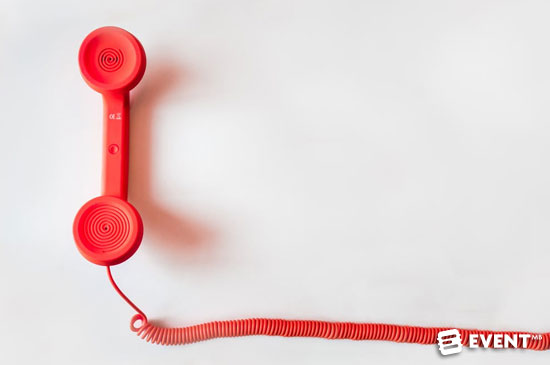Skift Take
While we hope that all of our events are sell out situations, some come close to the wire. If it’s last minute and you still have seats to sell, here are a few sure-fire ways to get them sold.
It all seemed to be going so well. The early-bird pricing showed promise. You lined up excellent speakers in a to-die-for venue and then when you should just be watching the last-minute RSVPs and tickets getting purchased, you realize the numbers aren’t where they should be. Panic sets in. What went wrong? Why aren’t your tickets purchased meeting your preliminary estimates and what can you do with only a few days left?
##abovethefold##
If you’re struggling with lackluster last-minute event numbers, there are a few things you can do besides freak out. You can:
- Do a targeted social media buy
- Strengthen your email marketing
- Offer a referral incentive
- Re-examine the registration process
- Get on the phone
- Perform a retargeting campaign
Why Are Your Event Numbers Down?
While this is primarily a time for action, it does benefit you to give some quick thought to why your numbers are down before implementing any of the above solutions. If this is an annual event or one that has taken place before ask yourself:
- What did we change from last year to this one?
- What did we forget to do?
- What is on the larger landscape this year that wasn’t there last (perhaps a competing conference)?
If this is a new event you’ll want to think about the type of marketing you did and whether your projections were realistic for a new event.
Once you’ve reviewed these things in your mind and with your team, it’s time to take action with some last minute event marketing.
-
Do a Targeted Social Media Marketing Buy
It’s time to take out ads on social media, but the first group you want to hit are those people who are in your venue’s area. There’s no point in contacting someone who needs to travel 2,000 miles to attend your event with only a week’s notice. You need people who can jump in a car or Uber and get there fast.
You can do a broad social media ad campaign but you’ll likely be wasting a lot of money on people who simply can’t navigate the logistics at the last minute. Instead, drill down to those who show an interest in your topics or industry and can get to your location easily.
Here are the steps for targeting on Facebook, targeting on Twitter, and a primer if you’re new to social media advertising.
Another form of targeting you’ll want to do is cull your database for locals. These people have a connection to you or your event and can get there quickly. They will be more likely to act than someone who has to coordinate a travel schedule. Plus, you’ll need your local data for several of the next steps.
While you’re doing a targeted social media campaign, do not forget to use your free social media to continue to promote your event. Sometimes potential attendees are still on the fence and seeing your fun posts could be what swings them at the last moment. Just make sure in those posts that you give links to register or buy tickets. You don’t want a lack of ease to keep anyone from following an emotional urge to buy.
-
Strengthen Your Email Marketing

Ideally, you have been using email marketing all along to market your event but if not, there’s one thing you need to do at this last-minute point in time. That’s personalization. Go back to your database and segment it by the following filters:
- Pull out people who live near your venue but who haven’t signed up yet. These people could easily come to your event with very little planning.
- Those who attended in the past but who are not signed up to attend.
- Those who are signed up already.
Next, launch several email marketing campaigns. Draft an email that will be part of a drip marketing campaign to get those nearby to come to your event. If you have the time, send 2-3 emails reminding them of the event and directing them to the sign-up page.
Continue to market aggressively to those who click but do not buy a ticket. Their click shows interest. If time allows, send them content on justifying the cost of the event, more details about the benefits attending, and other pieces directed at people that show interest. Learn more about drip marketing and email marketing as well as the types of emails you should be sending.
-
Offer a Referral Incentive or Special Offer

For those in your email list/database who are signed up, provide them with a referral incentive of some kind. Offer them something for bringing a friend. They’re already attending, it’s easy enough to bring someone with them. You could also offer a buy two, get one free incentive. Go back to your list and contact everyone who already bought two tickets and offer them a free one. This will make people feel appreciated and will help you fill seats. But do not offer both incentives or you run the risk of having the opposite effect.
If you’re hosting a multi-day conference, you could also create a “spouse” ticket that would give them partial access to some of your sessions and parties for a fraction of the cost.
Contests are also effective ways to fill seats. You can create a social media contest with a free ticket prize – just make sure that your contest is visible on social. Give it a hashtag and ask people to vote for the winners or something that’s engaging. Not only will you fill seats but you’ll get people talking and create a buzz as well.
Don’t forget your sponsors. You can always give free tickets to your sponsors so they can give them to their top customers and prospects, which could open up a new avenue of future attendees for you too.
-
Re-examine the Registration Process
Have someone you can trust go through the registration process for you and point out any sources of friction. Are there any parts that are unclear or confusing? Is your technology working the way it should? Does it work correctly on mobile? Visitors can be a lot less patient than you might imagine. If something is hard to do, they may just give up on it. Plus, many purchases are emotional reactions, something that is acted on in a spur of the moment. If there’s any sort of challenge you are giving the potential attendee a reason to spend their money and time elsewhere.
After you’re sure your registration process is as fluid and easy as possible, you can look at additional ways to lubricate the process. For instance, you can use language about being nearly sold out or just a few seats left. However, don’t use this terminology if your “few seats left” is really more like several hundred. You want to inspire action but not at the risk of honesty. If you have a lot of seats left use phrases like “Don’t miss out” and “last few days to buy.” Those phrases aren’t deceptive.
-
Get on the Phone

Even with all our technology, one of the best ways to encourage ticket purchases at the last-minute is calling people on your list. If time is at a premium, concentrate on calling your locals and people who have attended in the past. Locals can easily make the trip and people who have attended in the past should know the value of your event.
If this is a brand new event, concentrate on calling people who engage with you or your client frequently. You don’t have time to “sell” people who don’t know much about you at this point.
-
Perform a Retargeting Campaign
Have you ever visited a website where you’re about to make a purchase and then changed your mind? Later on, as you go about your business on the Internet you see ads for that item or service everywhere. Is it serendipity and the universe trying to tell you to reconsider? No, it’s retargeting.
Retargeting, or remarketing as it’s sometimes called (mainly by Google), is a smart use of your time because it works on people who have already shown interest in your event by doing something like visiting your website, Facebook or LinkedIn page.
The tech is not all that complicated. When someone visits your page, they’re “cookied” (the language is different from Facebook to LinkedIn) but essentially they carry with them a virtual souvenir of your site (unbeknownst to them) and it allows you to influence the ads that show around the Interwebs for them. Suddenly, you and your event are everywhere. The thought behind remarketing is that if you’re top of mind, the conversion or ticket purchase won’t be too far behind.
The Do’s and Dont’s of Last-Minute Event Marketing
If you’re not quite meeting your BS goals (butts in seats) you need all team members contributing. Since you have a finite amount of time, you don’t want to waste it on activities that aren’t going to yield results. Try these last-minute suggestions.
Do:
- Talk about your event on social media groups and pages. Whenever possible encourage people outside of your organization to do the same.
- Invite people on social media so that when they accept, others will see that they are going.
- Circulate past attendee comments. Reviews are a great way to persuade someone who’s considering buying a ticket.
- Talk to industry organizations that may be a good fit for your event or have a similar audience. You can even give them a discount for their members, which makes them look like rock stars for arranging that. If your event is cause-based, you might consider reaching out to similar non-profits and giving them a few seats.
- Host an employee contest to sell tickets. Encourage them to promote your event and offer prizes for the person who sells the most. This can easily be tracked through a discount code.
Don’t:
- Offer a discount for no reason on a recurring event just to sell tickets. By doing so publicly, you are teaching your audience to wait until the very last minute each year to purchase tickets at a deep discount. This is not a pattern you want to create. Instead, use a reason such as “past attendee” or “loyal attendee” when giving discounts.
- Let your stress level over empty seats kill your creativity in filling them. Just imagine they will get filled, if you do the work.
- Forget to plug the other fun aspects of your event like the location or the speakers. Often these types of extras are what make the difference. Purchases are an emotional choice. Find that button or that item/thing that sways them and they’ll buy instantly. Sometimes that’s as easy as referencing the poolside cabana that guests mill about between sessions.
- Think that every seat must be sold. Sometimes giving away a seat or selling a ticket at a deep discount is better than an empty one. Plus, look at every new attendee as a chance to shine and sell next year’s event to them. If this isn’t a recurring event, you can still make a good impression and add them to your marketing list for other events in the future.
- Forget your communications and social media posts should all have clear calls to action. Use buttons where possible for higher conversion rates. Don’t leave any question about what it is that you want visitors or readers to do – buy a ticket.
- Go into hard sell mode across your social media channels. Pumping out sales messages with no interaction and value in between is unlikely to have the desired effect.
In Conclusion
When you don’t have enough tickets sold and the event is fast approaching, it can seem like a nightmare of stress and panic. Maintaining a level of cool will help you get people on the fence to make the commitment. You just have to go where they are and make sure they hear your message. They won’t decide to join you if they aren’t thinking about your event. Obtaining top of mind positioning is essential to selling more tickets. These tips will help.
Additional Reading on How to Increase Your Attendee Count at the Last Minute
Event Email Templates and Designs that Convert into Attendees
20 Tips to Get Attendees to Open Your Emails
How to Get Attendees to Sell Tickets for You






